Performance Reporting — Continued
Goal 2: BC Employment and Assistance Services Support Self-reliance
Objective
Persons with disabilities find employment through employment
programs specifically tailored to meet their needs |
Strategy
Design employment programs for persons with disabilities |
Measure 2.1: Number of people who contact MHR offices and are
diverted to employment
Results
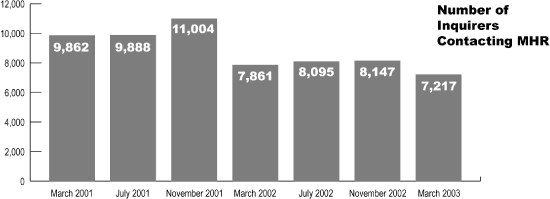
| 2002/03
Target |
Results |
| Establish baseline number of people who
contact MHR offices and are diverted to employment |
Baseline for number of
people who contact MHR:
7,217
a month
|
Description
Many people who contact the ministry are able to find employment
quickly before applying for income assistance. This measure offers
insight into the proportion of potential applicants who can be
diverted to employment.
The ministry offers services to assist people to find employment
before they become BCEA clients. Services provided include web-based
orientation sessions, work search guidelines, and an independent
work search toolkit. The intent of this measure is to monitor
the effectiveness of these services in assisting people to find
employment before applying for income assistance.
For the purposes of this measure, the ministry defines a contact
as someone who has completed a pre-application form. The number
of contacts with the ministry declined from an average of approximately
9,800 per month to 7,200 per month between 2001 and 2003. The
ministry interprets this decline as a positive trend indicating
a strengthened economy and the availability of web-based information
and other resources that partially replace the need for office
visits. Some potential clients appear to be finding work or other
alternatives to income assistance before completing a pre-application
form, thus reducing this number. A baseline of 7,217 persons contacing
ministry was established.
Why This Measure is Important
Diverting people to employment encourages self-reliance and reduces
reliance on income assistance. It breaks the cycle of dependency
that can begin the first time a client receives assistance. Research
shows that long-term dependence on income assistance has a negative
impact on individuals and families. For example, children from
income assistance families are approximately six times more likely
than children from working families to need assistance as adults.
Improvements To Measure
This measure was not fully implemented during 2002/03 because
of concerns about data collection when following up to determine
whether people contacting the ministry had moved into employment.
Changes in ministry procedures make it clearer to people contacting
the ministry that the ministry may follow-up with them to determine
whether they have moved into employment. Information on employment
will be collected through the ministry' Exit Survey, which captures
both former clients and others who completed a pre-application
but did not become a client.
New Measure (2003/04): Per cent of inquirers contacting BCEA
offices who are diverted to employment
| New Measure |
|
2002/03 |
2003/04 |
2004/05 |
2005/06 |
| Per cent of inquirers contacting
BCEA offices who are diverted to employment |
Targets |
N/A |
Establish Baseline |
|
|
| Results |
N/A |
|
|
|
Data Reliability and Assumptions
Source: Ministry database.
Data reliability for the new measure is high, as the ministry
tracks inquirers as they complete pre-application forms. The number
of inquirers who do not become clients represents the number of
inquirers diverted. During 2002/03 the ministry did not follow
up with inquirers to see if they found employment. The ministry
is enhancing its exit survey to capture this information in the
future.
Other Comments
Every person who contacts an MHR office can be assessed for emergency
needs, such as an urgent need for food, shelter, or medical attention.
Inquirers who have an emergency need will receive an expedited
application for income assistance.
Objective
Temporary Assistance is provided to individuals eligible for
short-term financial support |
Strategy
Develop legislative criteria to define eligibility for Temporary
Assistance |
Measure 2.2: Number of persons meeting the legislative criteria
who receive Temporary Assistance
Results
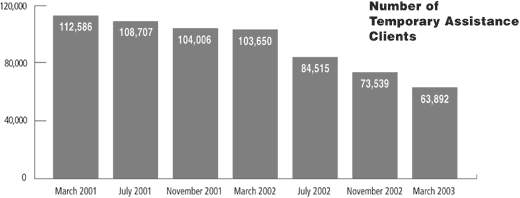
| 2002/03 Target |
Results |
| Establish baseline number of persons receiving
Temporary Assistance |
Baseline established:
63,892
|
Description
This measure indicates the overall level of short-term dependence
on income assistance. The number of clients receiving temporary
assistance declined steadily from March 2001 through March 2003.
A lower number implies sound policy, a stronger economy and more
people working. The baseline established in 2002/03 was 63,892
persons receiving income assistance. This is the year end (March
2003) figure.
Why This Measure is Important
Clients who leave income assistance tend to have higher incomes,
their children are less likely to receive income assistance as
adults, and they attain higher levels of training and education.
Children whose parents work are also more likely to complete high
school and be actively involved in the labour market as adults.
Improvements To Measure
The number of persons receiving assistance is a key measure for
the ministry, but it is more meaningful if expressed as a percentage
of the provincial population. In 2003/04, the ministry will report
on the percentage of B.C.'s population receiving income assistance
in general and the percentage receiving temporary assistance.
This measure is being reported in government's strategic plan.
The ministry will also report on the percentages of the caseload
receiving temporary and continuous assistance. In combination,
these measures describe the effectiveness of BC Employment and
Assistance in moving people toward sustainable employment and
assisting individuals and families in need.

New Measure (2003/04): Per cent of B.C. Population Receiving
Income Assistance, and Per cent of B.C. Population Receiving Temporary
Assistance
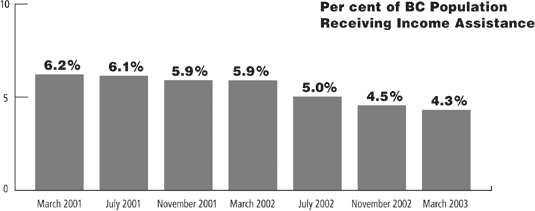
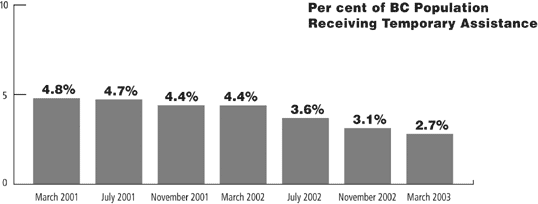
The targets established for the new measures are 5.4 per cent
of British Columbians receiving income assistance and 3.5 per
cent of British Columbians receiving temporary assistance. The
2002/03 results were better than both targets, with just 4.5 per
cent of the population receiving income assistance, and 3.0 per
cent receiving temporary assistance.
| New Measures |
|
2002/03 |
2003/04 |
2004/05 |
2005/06 |
| Per cent of B.C. Population
Receiving Income Assistance |
Targets |
5.4% |
4.8% |
4.3% |
3.7% |
| Results |
4.5% |
n/a |
n/a |
n/a |
| Per cent of B.C. Population
Receiving Temporary Assistance |
Targets |
3.5% |
3.0% |
2.5% |
2.0% |
| Results |
3.0% |
n/a |
n/a |
n/a |
Data Reliability and Assumptions
Source: Information on population is obtained from BC Stats.
Ministry data is obtained from ministry databases.
Data reliability for the new measure is high, as it is drawn
from existing caseload and population data.
Comments
Cross-jurisdictional comparisons of the percentage of the population
on income assistance are difficult because eligibility is defined
provincially and it is not consistent across provinces.
Objective
Clients participate in employment or volunteer in the community
as they are able |
Strategy
Align services to promote employment or volunteering |
Measure 2.3: Percentage of Continuous Assistance clients who
work or participate in volunteer activities
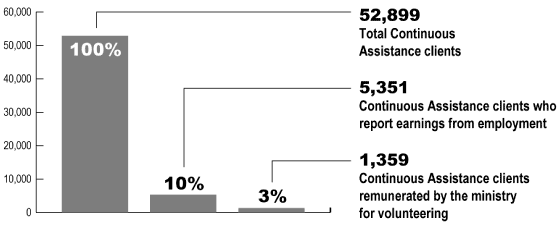
| 2002/03 Target |
Results |
| Establish baseline number of Continuous
Assistance clients involved in work or volunteer activities |
Baseline established:
5,351 Continuous Assistance clients who work
1,359 Continuous Assistance clients who volunteer
|
Description
This measure points to the level of self-reliance and community
involvement attained by clients who are not expected to achieve
independence through employment. Continuous Assistance clients
include persons with disabilities and others who face persistent
multiple barriers to employment. Employment activity is easily
identified because clients earning income are required to report
their earnings. Volunteer activity is identified through the client's
application for a Community Volunteer Program allowance, which
is provided by the ministry to assist some clients with related
costs, such as transportation. In 2002/03 baselines were established
with 5,351 continuous assistance clients reporting earned income
and 1,359 receiving a Community Volunteer Program Allowance.
Why this Measure is Important
In April 2002, the ministry introduced the Employment Strategy
for Persons with Disabilities (ESPD). The strategy includes the
Employment Program for Persons with Disabilities (EPPD), the Minister's
Council on Employment for Persons with Disabilities and a strategic
partnership with Human Resources Development Canada. All of these
initiatives support persons with disabilities to engage in employment
to the greatest degree possible. This may include part-time work
or volunteering. Successful programs should lead to increased
earnings and volunteer activities for continuous assistance clients.
Improvements To Measure
Clients who work are required to report their income, but clients
do not report participation in volunteer activities unless they
receive remuneration through the ministry's Community Volunteer
Program is involved. This will change in 2003/04 when the ministry
implements voluntary participation plans, which will report on
work and volunteer activities for people receiving continuous
assistance. This change will support improved data collection
for this measure, which remained unchanged in the 2003/04 –
2005/06 Service Plan.
Data Reliability and Assumptions
Source: Ministry database.
Data reliability for the new measures is high, as figures are
based on caseload data.
Objective
Continuous Assistance is provided to individuals who are not
expected to be able to achieve independence through employment
|
Strategy
Develop legislative criteria to define eligibility for Continuous
Assistance |

Measure 2.4: Number of persons meeting the legislative criteria
who receive Continuous Assistance (CA)
Results
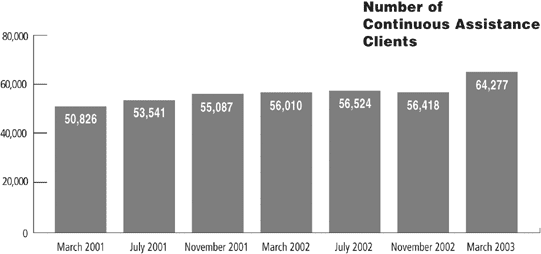
| 2002/03 Target |
Results |
| Establish baseline number of persons receiving
Continuous Assistance |
Baseline established:
64,277
|
Description
This measure illustrates trends in the number of clients who
are not expected to achieve independence through employment. The
increase from January 2003 to March 2003 is a result of a review
of existing cases that began in October 2002. Additional cases
were added to the continuous assistance caseload because some
clients previously considered to be on temporary assistance became
classified as Persons with Persistent Multiple Barriers. The baseline
that was established in 2002/03 was 64,277 persons receiving continuous
assistance, equal to the year-end (March 2003) figure.
Why This Measure is Important
The ministry's mandate is to provide services that move people
toward sustainable employment and assist individuals and families
in need. Clients receiving continuous assistance may have disabilities
or face persistent multiple barriers to employment. These clients
are expected to account for an increasing proportion of the caseload
as the number of employable clients move into employment. This
measure will track that change over time.
Improvements To Measure
The ministry has refined this measure to capture the proportion
of the caseload comprised of people receiving continuous assistance
(as opposed to simply the total number of clients), as well as
the proportion receiving temporary assistance. This new measure
links to the ministry's and government's priorities of providing
assistance to those in need.
New Measure: Per cent of total caseload receiving temporary
assistance, and per cent of total caseload receiving continuous
assistance
Results
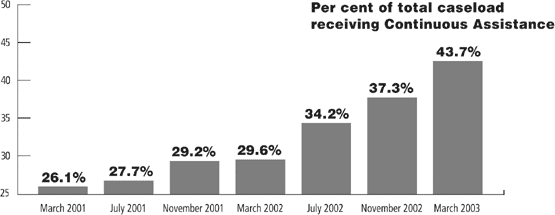
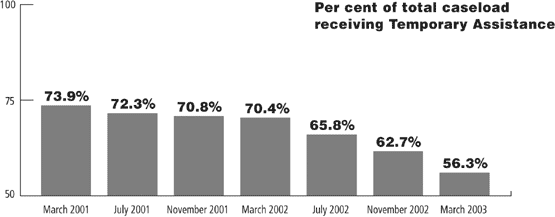
| New Measures |
|
2002/03 |
2003/04 |
2004/05 |
2005/06 |
| Per cent of total caseload
receiving temporary assistance |
Targets |
70% |
64% |
58% |
52% |
| Results |
56.3% |
n/a |
n/a |
n/a |
| Per cent of total caseload
receiving continuous assistance |
Targets |
28% |
29% |
34% |
46% |
| Results |
43.7% |
n/a |
n/a |
n/a |
The targets established for these new measures are 70 per cent
of the caseload receiving temporary assistance and 28 per cent
of the caseload receiving continuous assistance. In 2002/03, 56.3
per cent of the caseload was receiving temporary assistance and
43.7 per cent were receiving continuous assistance.
The higher proportion of the caseload receiving continuous assistance
is largely due to the reduced number of clients receiving temporary
assistance.
Data Reliability and Assumptions
Source: Ministry database.
Data reliability for the new measure is high, as they are based
on caseload data.
Other Comments
The numbers captured by these measures are expected to fluctuate
during 2003/04 as reviews are completed on existing cases. Over
time, as more employable people are linked to employment, continuous
assistance clients are expected to make up an increasing majority
of the income assistance caseload.
